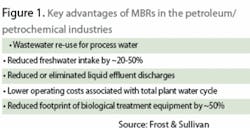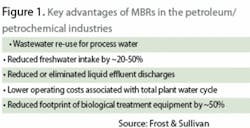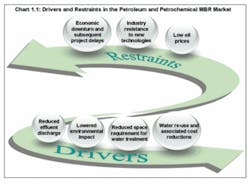MBR Applications Offer Advantages to Pettroleum & Petrochemical Wastewater Treatment
by Cameron Wilson
While slow to adopt membrane bioreactor technology, the oil & gas industry could benefit from greater reuse options to lower water, regulatory costs
Membrane bioreactor (MBR) technology has evolved since its inception in the 1960s. It involves a combination of traditional sludge treatment with membrane separation – ultrafiltration – to produce high quality effluent with a relatively small footprint in comparison to conventional treatment systems. An early commercial adopter was the municipal wastewater industry, for which the technology was ideally suited due to the relatively low complexity of the waste stream and high quality effluent. Petroleum and petrochemical applications required work to address the specific constituents of their effluent streams. Although these issues have been addressed, growing demand for water re-use/recycling in the petrochemical and refining industries have made MBRs the technology of choice in regions with stiff regulations or costs associated with freshwater uptake. Historically, MBR technology hasn't been a cost effective solution for the petroleum and petrochemical industry as the benefits of high quality effluent didn't carry the same value as they do today. Capital costs of this technology now are easily outweighed by savings on effluent discharge and freshwater uptake. In regions with freshwater scarcity, such as the Middle East or U.S. Southwest, MBR technologies can drastically reduce costs associated with obtaining process water.
MBR Market Drivers
While regulatory pressures are typically the key drivers for most water-related technology, economic factors are also a consideration.
Figure 1 lists the main advantages of MBR technology for wastewater treatment in the petroleum and petrochemical industries expressed by key industry participants. This technology produces effluent suitable for reuse in various refinery processes, including cooling tower water and boiler feed water.
Refineries and petrochemical plants can effectively reduce their freshwater intake by 20-50% using MBR systems to treat their wastewater.
Regarding operating costs when viewed from a plant-wide perspective, they're a money-saving technology when recycled water and reduced effluent discharge are taken into account.
Solution Provider Challenges
The North American petroleum and petrochemical industry historically has been cautious when considering new or innovative technologies for water treatment. As such, it's been somewhat slow to adopt this technology as it has become available. References and data from early North American installations, as well as European, Middle Eastern and South American industry participants who've been slightly more accepting of membrane technologies for wastewater treatment, are beginning to demonstrate the value of MBRs for these applications. Also, while the early part of 2008 yielded record profits in the oil and gas sector, the recent economic slowdown has had its effect on capital expenditures from the industry. MBR technology would typically be added either to a new-built plant or, during an upgrade, to an existing plant. The challenge for key solution providers like GE Water & Process Technologies, Siemens Water Technologies, Veolia Water Solutions & Technologies and Koch Membrane Systems is to demonstrate a full understanding of the overall wastewater treatment system and how to maximize benefits of this technology in each application. Chart 1 depicts the drivers and restraints affecting the market for MBRs in the petroleum and petrochemical industry and their relative strengths. In the current economic climate, many plans for added capacity are on hold so the key for adoption of this technology will be economic incentives it provides in and of itself. With the recent change in the U.S. government, revisions in policies regarding water-use and effluent discharge could act as a driver for adoption of this technology in the short term. Further, arid regions like the Middle East or the U.S. Southwest may choose to adopt this technology in the short term to reduce future costs.
Future Potential Applications
While typical applications of MBR technology focus on recycling of wastewater from downstream activities, some governments and petroleum producers are looking to capitalize on co-produced water by treating it and providing it as a feedstock for industrial, agricultural and in some cases municipal uses. Promising research is under way to convert the 3+ barrels of water brought to the surface along with each barrel of oil into a useable freshwater resource. The process involves a number of pre-treatment stages followed by MBR treatment, and reverse osmosis. The result of this process is a useable source of freshwater from co-produced water that would otherwise be re-injected. Current disposal of co-produced water accounts for approximately 10% of the costs of crude oil production. If beneficial uses of co-produced water can justify the cost of treatment, the petroleum industry could become a net producer of freshwater instead of a net consumer.
Conclusion
While this technology clearly shows advantages with respect to water use, effluent discharge, and cost savings, the outlook for the adoption rate remains slow in light of the current economic climate. As the economy begins to recover and plans for upgrades and expansions to refining capacity resume, Frost & Sullivan expects the petroleum and petrochemical industry will likely look to MBRs for wastewater treatment in place of conventional biological treatment equipment.
About the Author: Cameron Wilson is a research analyst at Palo Alto, CA-based global growth consulting company Frost & Sullivan's Environmental & Building Technologies practice. Contact: [email protected] or www.frost.com

